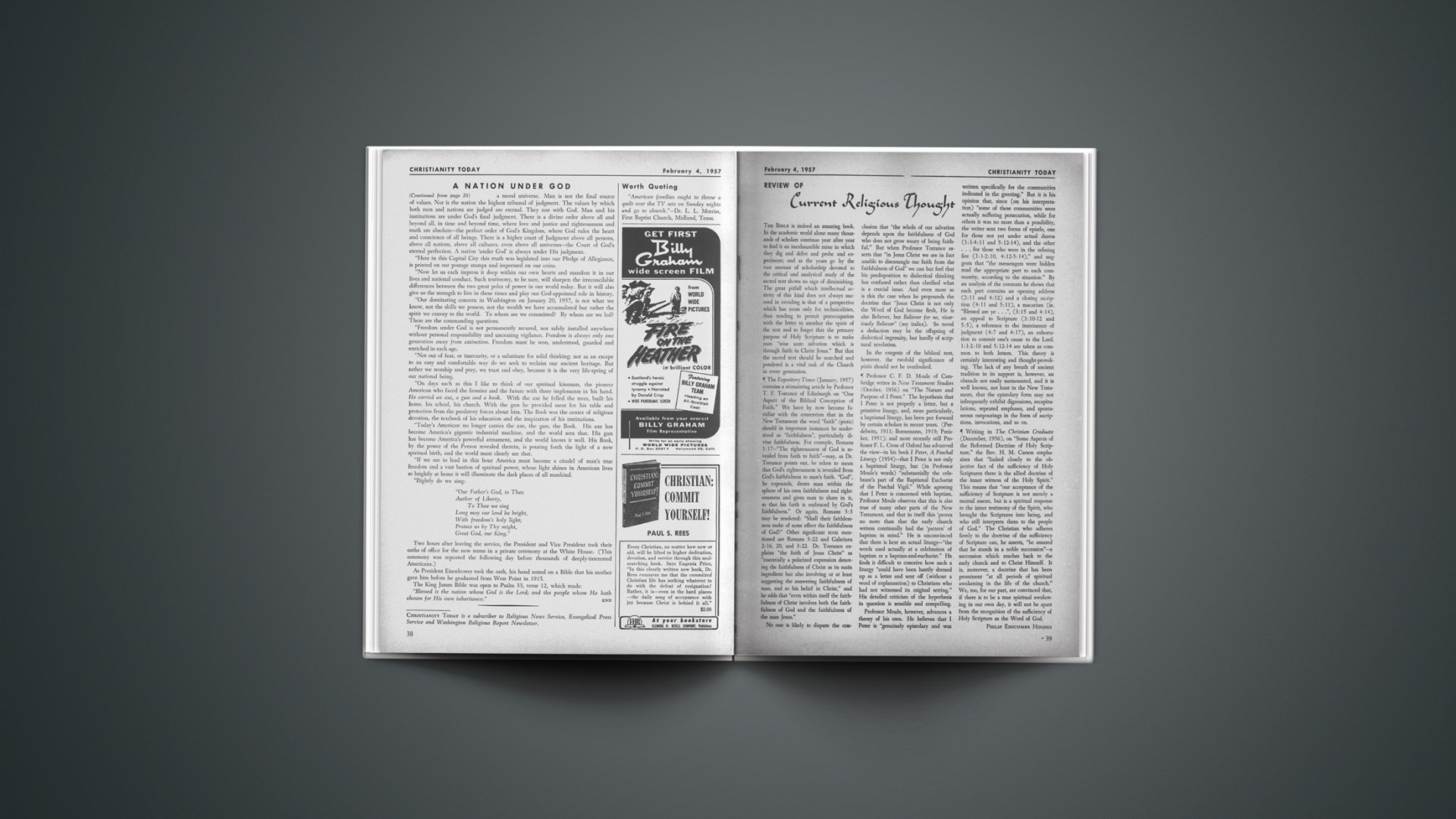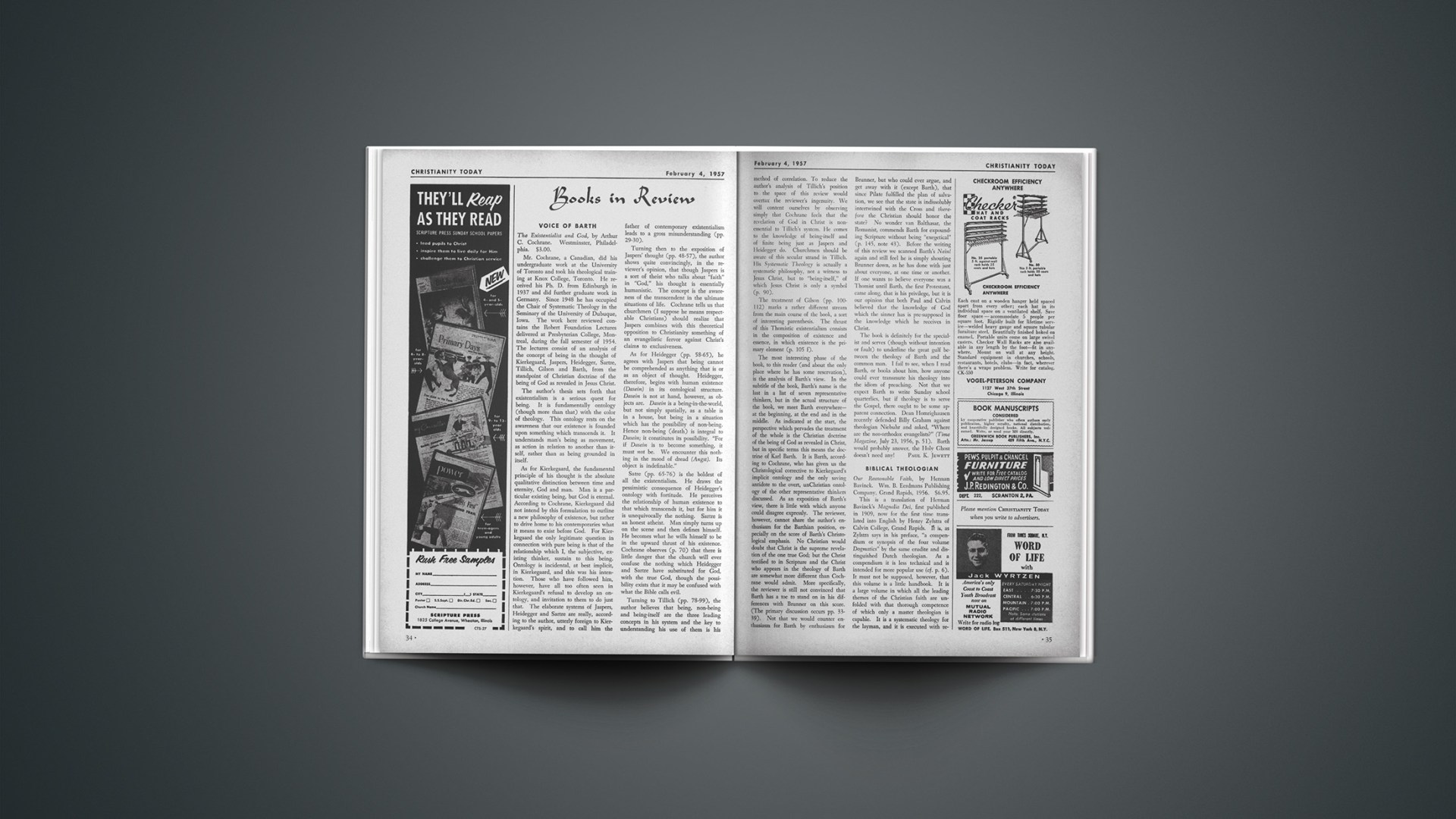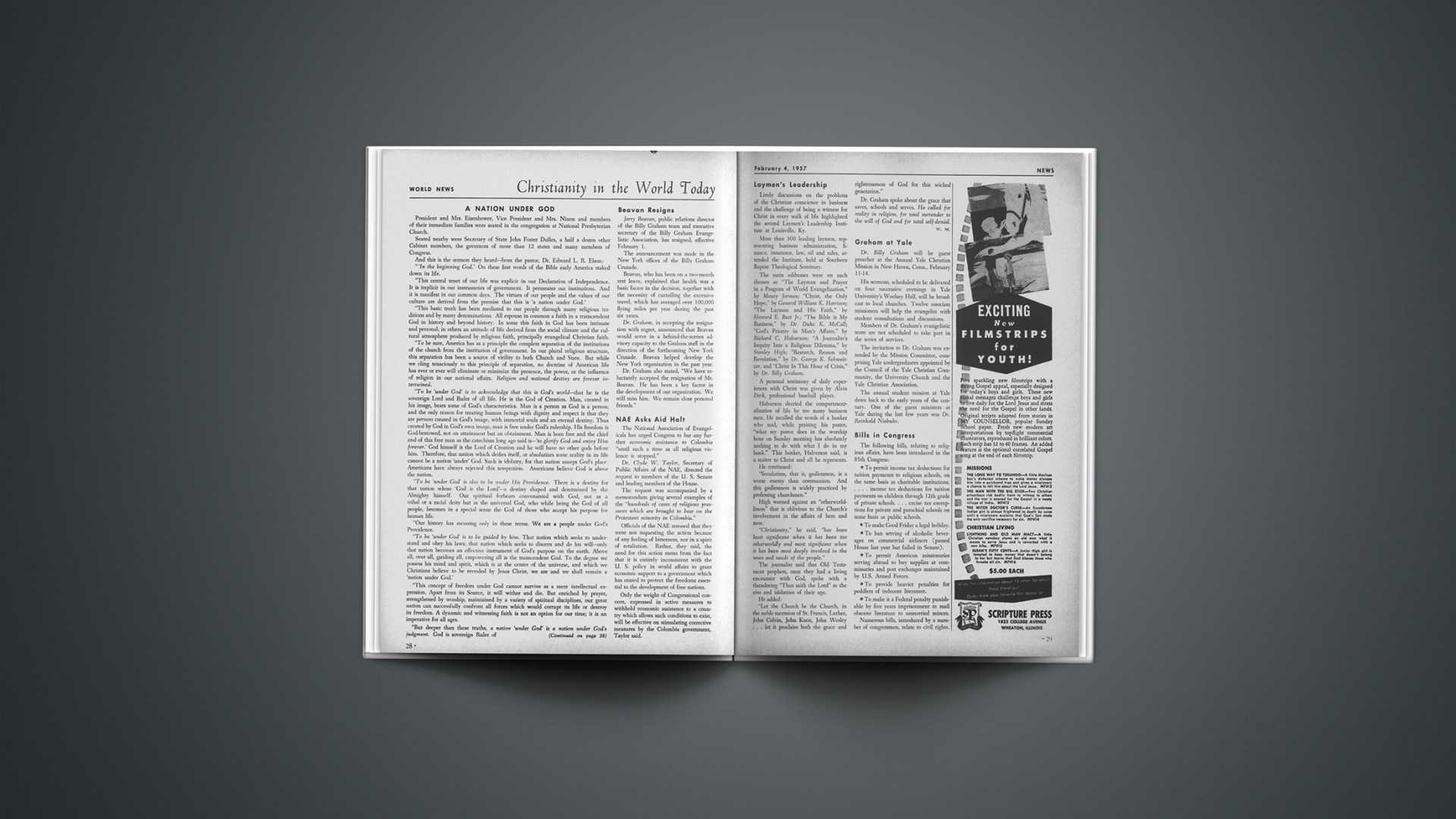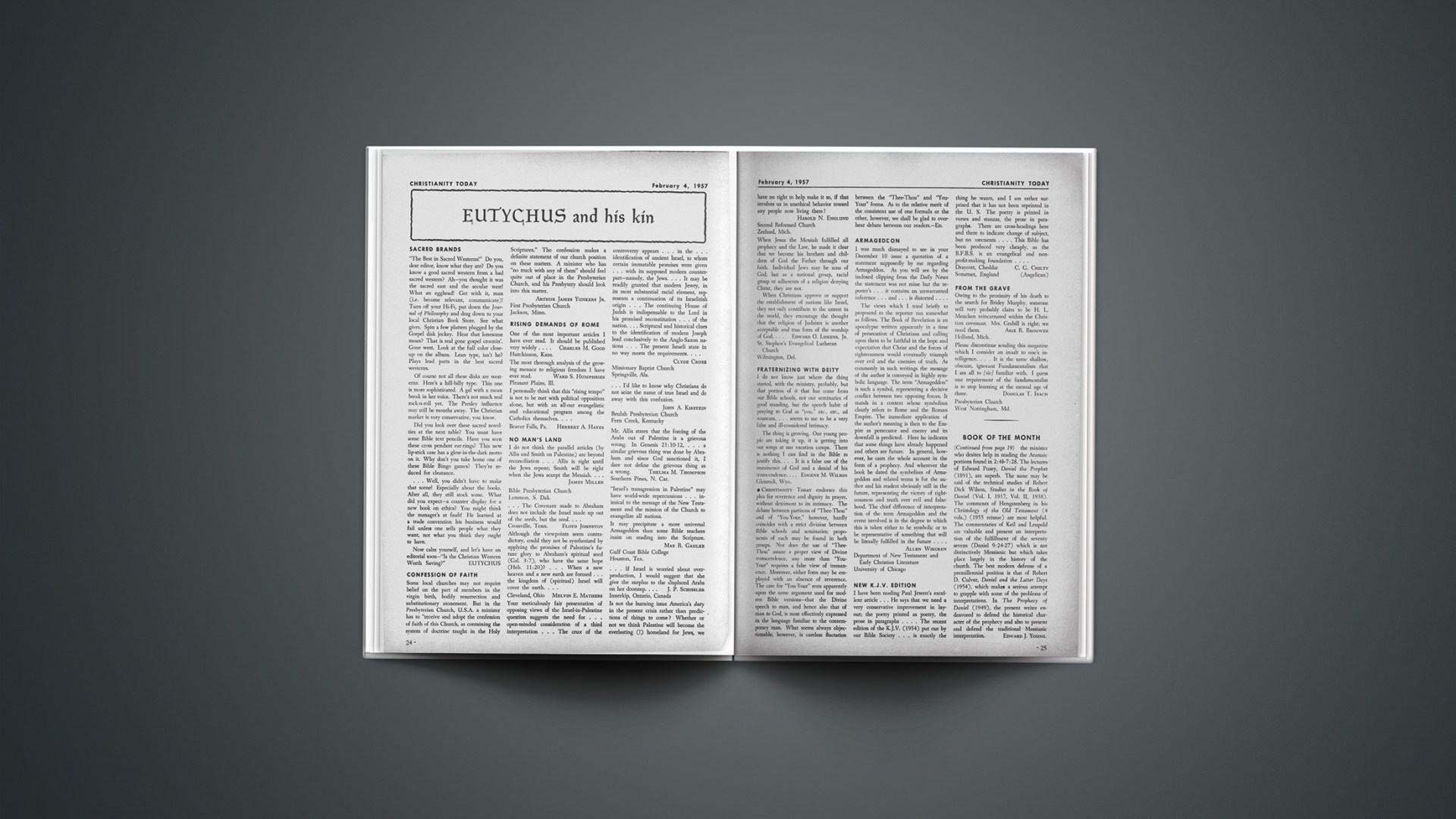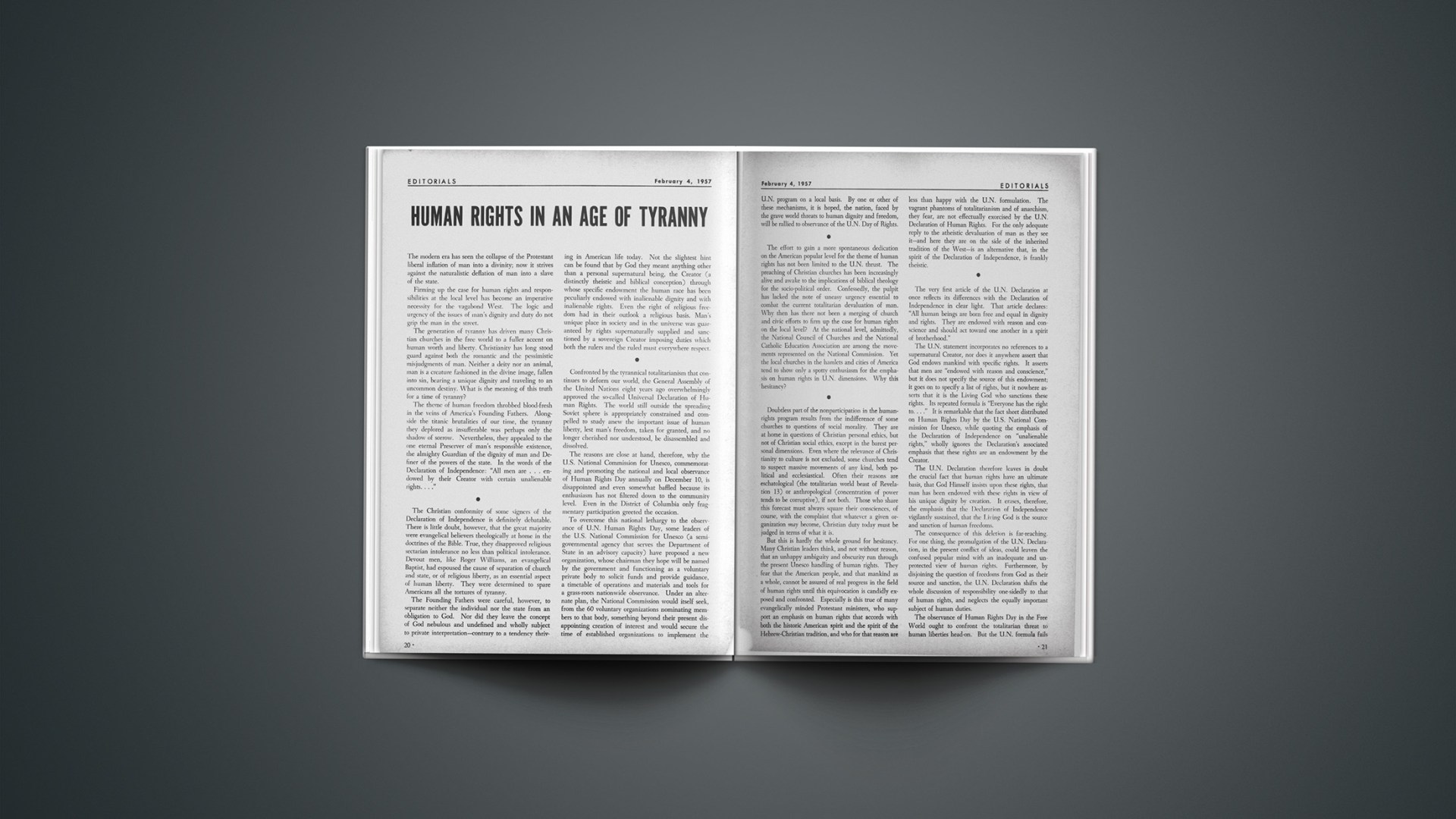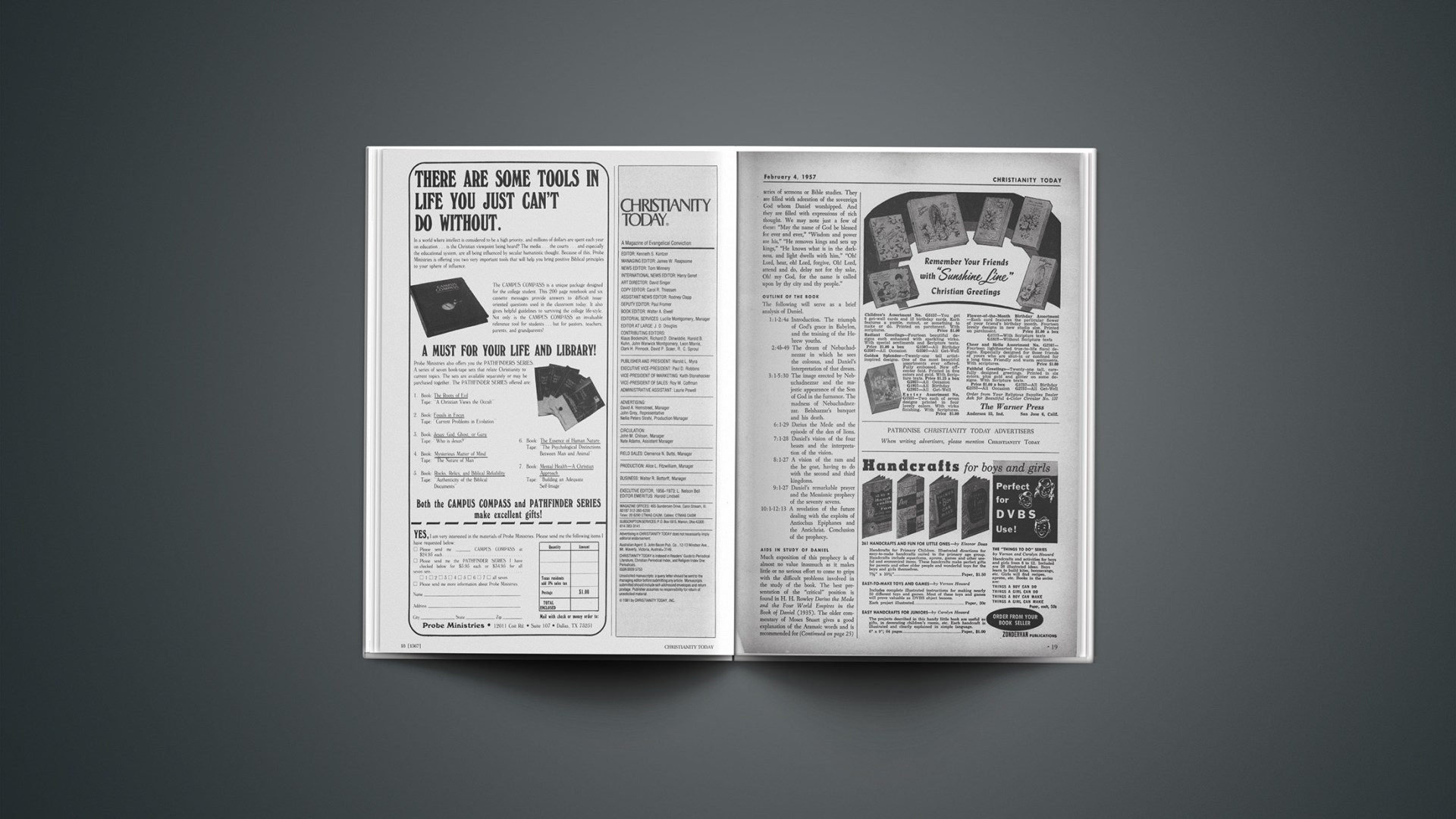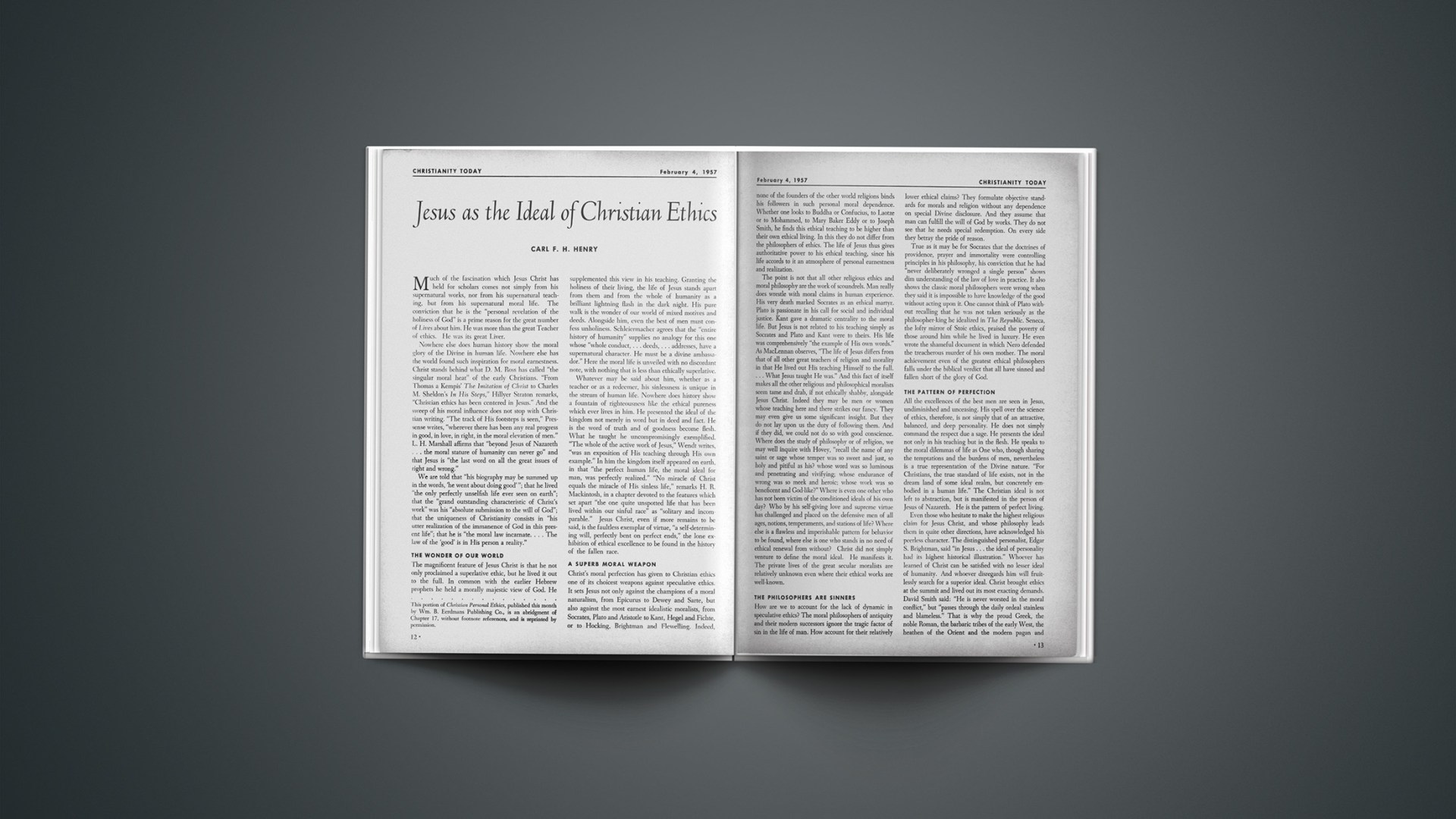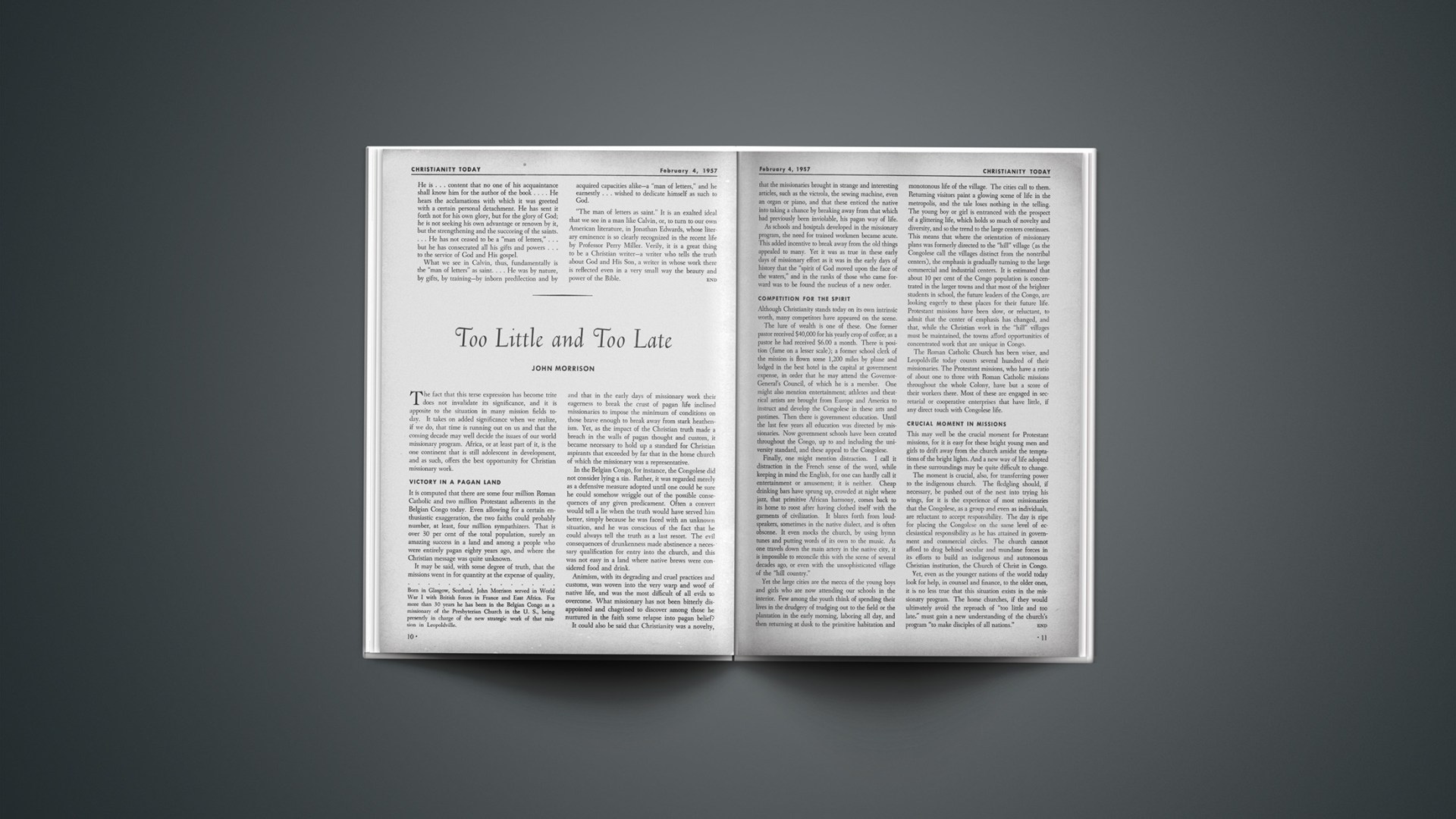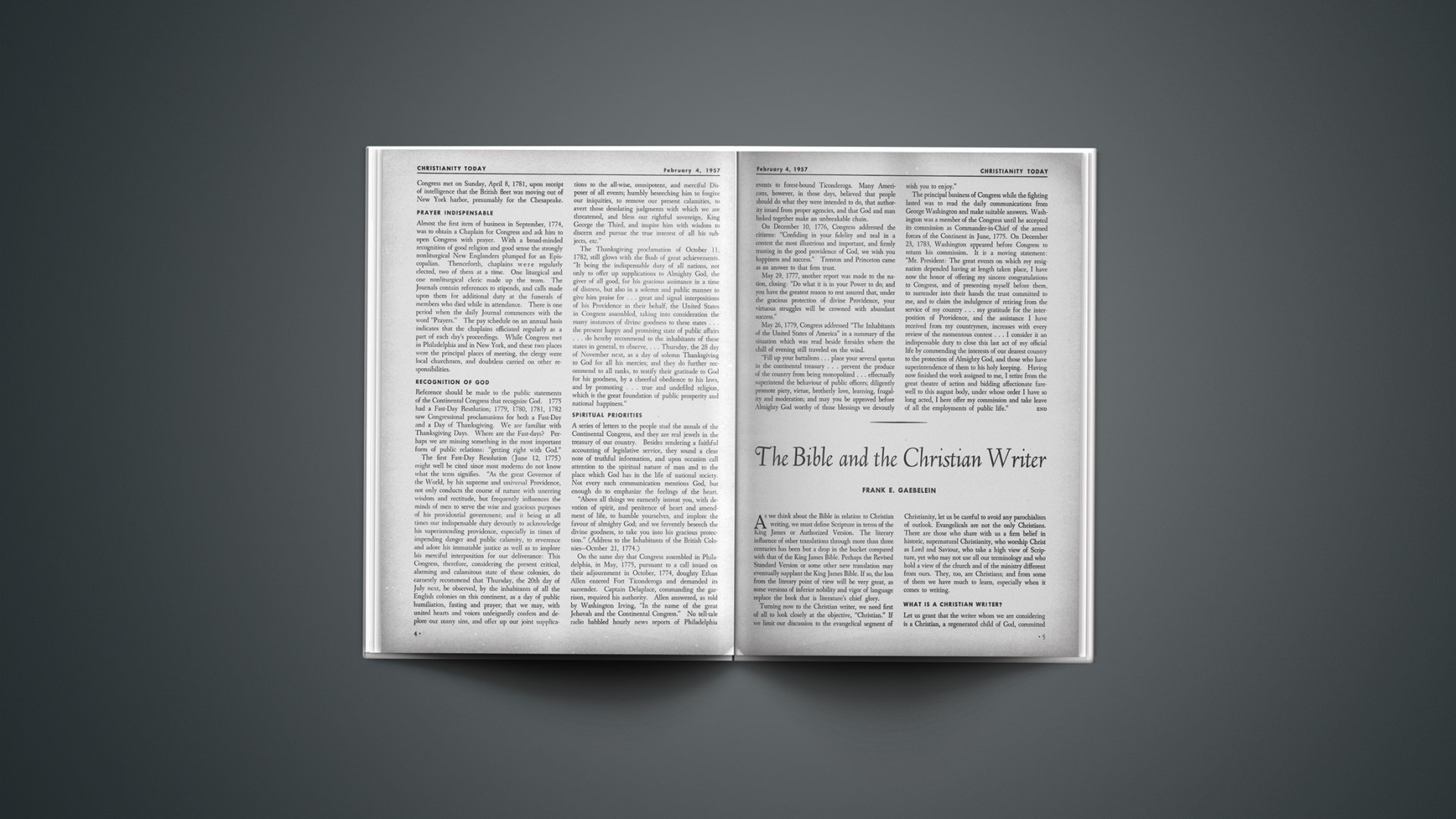The Bible is indeed an amazing book. In the academic world alone many thousands of scholars continue year after year to find it an inexhaustible mine in which they dig and delve and probe and experiment; and as the years go by the vast amount of scholarship devoted to the critical and analytical study of the sacred text shows no sign of diminishing. The great pitfall which intellectual activity of this kind does not always succeed in avoiding is that of a perspective which has room only for technicalities, thus tending to permit preoccupation with the letter to smother the spirit of the text and to forget that the primary purpose of Holy Scripture is to make man “wise unto salvation which is through faith in Christ Jesus.” But that the sacred text should be searched and pondered is a vital task of the Church in every generation.
The Expository Times (January, 1957) contains a stimulating article by Professor T. F. Torrance of Edinburgh on “One Aspect of the Biblical Conception of Faith.” We have by now become familiar with the contention that in the New Testament the word “faith” (pistis) should in important instances be understood as “faithfulness”, particularly divine faithfulness. For example, Romans 1:17—“The righteousness of God is revealed from faith to faith”—may, as Dr. Torrance points out, be taken to mean that God’s righteousness is revealed from God’s faithfulness to man’s faith. “God”, he expounds, draws man within the sphere of his own faithfulness and righteousness and gives man to share in it, so that his faith is embraced by God’s faithfulness.” Or again, Romans 3:3 may be rendered: “Shall their faithlessness make of none effect the faithfulness of God?” Other significant texts mentioned are Romans 3:22 and Galatians 2:16, 20, and 3:22. Dr. Torrance explains “the faith of Jesus Christ” as “essentially a polarized expression denoting the faithfulness of Christ as its main ingredient but also involving or at least suggesting the answering faithfulness of man, and so his belief in Christ,” and he adds that “even within itself the faithfulness of Christ involves both the faithfulness of God and the faithfulness of the man Jesus.”
No one is likely to dispute the conclusion that “the whole of our salvation depends upon the faithfulness of God who does not grow weary of being faithful.” But when Professor Torrance asserts that “in Jesus Christ we are in fact unable to disentangle our faith from the faithfulness of God” we can but feel that his predisposition to dialectical thinking has confused rather than clarified what is a crucial issue. And even more so is this the case when he propounds the doctrine that “Jesus Christ is not only the Word of God become flesh, He is also Believer, but Believer for us, vicariously Believer” (my italics). So novel a deduction may be the offspring of dialectical ingenuity, but hardly of scriptural revelation.
In the exegesis of the biblical text, however, the twofold significance of pistis should not be overlooked.
Professor C. F. D. Moule of Cambridge writes in New Testament Studies (October, 1956) on “The Nature and Purpose of I Peter.” The hypothesis that I Peter is not properly a letter, but a primitive liturgy, and, more particularly, a baptismal liturgy, has been put forward by certain scholars in recent years. (Perdelwitz, 1911; Bornemann, 1919; Preisker, 1951); and more recently still Professor F. L. Cross of Oxford has advanved the view—in his book I Peter, A Paschal Liturgy (1954)—that I Peter is not only a baptismal liturgy, but (in Professor Moule’s words) “substantially the celebrant’s part of the Baptismal Eucharist of the Paschal Vigil.” While agreeing that I Peter is concerned with baptism, Professor Moule observes that this is also true of many other parts of the New Testament, and that in itself this ‘proves no more than that the early church writers continually had the ‘pattern’ of baptism in mind.” He is unconvinced that there is here an actual liturgy—“the words used actually at a celebration of baptism or a baptism-and-eucharist.” He finds it difficult to conceive how such a liturgy “could have been hastily dressed up as a letter and sent off (without a word of explanantion) to Christians who had not witnessed its original setting.” His detailed criticism of the hypothesis in question is sensible and compelling.
Professor Moule, however, advances a theory of his own. He believes that I Peter is “genuinely epistolary and was
written specifically for the communities indicated in the greeting.” But it is his opinion that, since (on his interpretation) “some of these communities were actually suffering persecution, while for others it was no more than a possibility, the writer sent two forms of epistle, one for those not yet under actual duress (1:1–4:11 and 5:12–14), and the other … for those who were in the refining fire (1:1–2:10, 4:12–5:14),” and suggests that “the messengers were bidden read the appropriate part to each community, according to the situation.” By an analysis of the contents he shows that each part contains an opening address (2:11 and 4:12) and a closing ascription (4:11 and 5:11), a macarism (ie. “Blessed are ye …”, (3:15 and 4:14), an appeal to Scripture (3:10–12 and 5:5), a reference to the imminence of judgment (4:7 and 4:17), an exhortation to commit one’s cause to the Lord. 1:1–2:10 and 5:12–14 are taken as common to both letters. This theory is certainly interesting and thought-provoking. The lack of any breath of ancient tradition in its support is, however, an obstacle not easily surmounted, and it is well known, not least in the New Testament, that the epistolary form may not infrequently exhibit digressions, recapitulations, repeated emphases, and spontaneous outpourings in the form of ascriptions, invocations, and so on.
Writing in The Christian Graduate (December, 1956), on “Some Aspects of the Reformed Doctrine of Holy Scripture,” the Rev. H. M. Carson emphasizes that “linked closely to the objective fact of the sufficiency of Holy Scriptures there is the allied doctrine of the inner witness of the Holy Spirit.” This means that “our acceptance of the sufficiency of Scripture is not merely a mental assent, but is a spiritual response to the inner testimony of the Spirit, who brought the Scriptures into being, and who still interprets them to the people of God.” The Christian who adheres firmly to the doctrine of the sufficiency of Scripture can, he asserts, “be assured that he stands in a noble succession”—a succession which reaches back to the early church and to Christ Himself. It is, moreover, a doctrine that has been prominent “at all periods of spiritual awakening in the life of the church.” We, too, for our part, are convinced that, if there is to be a true spiritual awakening in our own day, it will not be apart from the recognition of the sufficiency of Holy Scripture as the Word of God.

